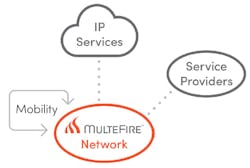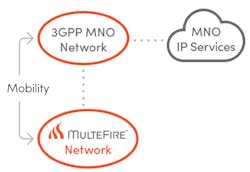Cellular systems offer many advantages, including reliable wireless communication through a global network. The downside is that anyone using the system must subscribe to a service provided by the major cellular companies that licensed the spectrum.
Many embedded applications can benefit from cellular technology. However, it would be on a much smaller scale, similar to what Wi-Fi provides but instead using LTE technology. This means employing unlicensed spectrum like that used by Wi-Fi. The MulteFire Alliance fosters technology targeting this space.
Part of the challenge of utilizing LTE in unlicensed spectrum is coexistence with similar cellular networks in the same area, as well as other technologies, like Wi-Fi, that employ the same spectrum. Such sharing is already the case with Wi-Fi, which isn’t the only technology that uses the 2.5- and 5-GHz bands. The 3.5-GHz Citizens Broadband Radio Service (CBRS) is also becoming available.
1. MulteFire networks can link to the internet through service providers that connect to these networks.
The MulteFire Alliance includes many well-known technology companies like Intel and SoftBank, plus cable companies such as Charter and Comcast. The list is rather extensive. MulteFire networks can be tied into service providers and other neutral host IP networks like the internet service provided by cable companies (Fig. 1).
MulteFire networks can also link to 3GPP Public Land Mobile Networks (PLMNs) that would include existing cellular networks operating on different bands (Fig. 2). The advantage is that the interchange operates with the same cellular exchange already used between cellular providers.
MulteFire LTE technology takes advantage of cellular security as well as the ability to build large networks with roaming capabilities. The system can use SIM and non-SIM credentials, including support for eSIM, an embedded SIM card implementation that reduces the bill of materials of an embedded solution. MulteFire Release 1.0 was available at the start of 2017.
2. MulteFire networks also can be linked to service provider cellular networks.
Target Applications
There are many applications where neutral host cellular solutions make sense. For example, large enterprises such as airports or even public-service-sector uses, including first responders, could take advantage of MulteFire technology. Like Wi-Fi, users can set up and tear down networks as needed.
Of course, conflicts and overuse of spectrum can be a challenge, as can be attested to by anyone trying to use Wi-Fi at events like the Consumer Electronics Show. Still, Wi-Fi and MulteFire will have plenty of areas where this type of problem won’t be an issue. MulteFire technology may actually operate better than some of the other wireless alternatives in dense deployment environments.
MulteFire is tightly aligned with 3GPP standards and builds on the 3GPP Release 131 and 3GPP 142 specifications for Licensed Assisted Access (LAA) and Enhanced Licensed Assisted Access (eLAA). It can support features such as Listen-Before-Talk (LBT).
MulteFire networks can handle the same type of traffic currently handled by existing cellular networks. This includes voice, video, and data. Suitable devices, e.g. smartphones, that can support both networks would be able to fallback to a different network, depending on numerous factors such as cost of connection.




